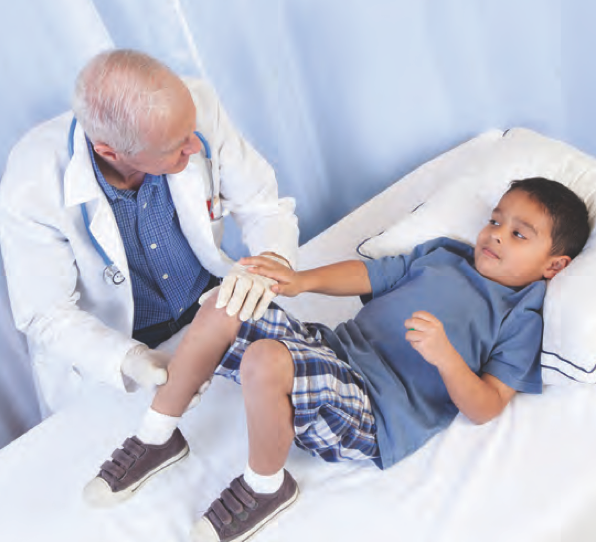Ouch! Common Sports Injuries in Children
More children are competing in athletic activities than ever before. While the numerous health benefits of physical activity are well documented (including weight management, bone health, and improved self-esteem), participation in formal athletics also carries the risk of injury.


Due to their skeletal immaturity, children are susceptible to different types of injuries than adult athletes. Three of the common injuries that children present to their pediatricians with are Little League Elbow Syndrome, Osgood-Schlatter Disease, and Sever Disease. The common theme with these injuries is overuse. Growing bones are especially vulnerable to overuse injuries because the growth plate is weaker than the ligaments and muscles that attach to it.
Little League Elbow Syndrome (LLE) encompasses different degrees of damage to the medial epicondyle (the pointy bone on the inside part of the elbow) that occur as a result of repetitive throwing motions. LLE is most common between the ages of 8 to 15 and is most often seen in pitchers (but other high volume throwing positions like catcher and shortstop are also susceptible). The repetitive stress to the growth plate of the medial epicondyle causes tissue damage, and when the damage exceeds the body’s ability to repair the tissue, injuries ensue. The injuries can include delayed or accelerated growth of the medial epicondyle, fragmentation of the epicondyle, fractures of the growth plate or loose bodies (bone chips) in the joint.
There is a direct link between the number of pitches thrown and elbow injuries. Most leagues have instilled “pitch count” rules, but they are not uniformly enforced, and more importantly, do not include other pitching sessions including practice and participation in multiple leagues. Single-sport participation with year round training can be especially problematic for young pitchers.
Similar injuries occur at the insertion of the patellar tendon (just below the knee cap) to the tibial tuberosity (the small point at the top of the front side of the lower leg bone), which is called Osgood-Schlatter Disease, as well as at the insertion of the Achilles tendon to the calcaneous (heel bone), which is Sever Disease.
Athletic events that include a lot of running and/or jumping, such as soccer, gymnastics, and basketball put children at risk for these lower extremity injuries. The large quadriceps muscles of the front of the thigh that straighten the leg attach at the tibial tuberosity and the repetitive pulling on that part of the shin bone causes a similar injury to LLE as outlined above. Likewise, the large calf muscles pulling through the Achilles tendon to where it inserts on the heel can cause pain/swelling of that growth plate.
The treatment for all of these conditions generally starts with rest. Pain causing activities should be limited or discontinued completely. Warming up well, stretching the muscles involved with these injuries prior to activity, and icing the affected painful areas after activities are important aspects of rehabilitation. Non-steroidal anti-inflammatory drugs like ibuprofen can also be useful. Wearing heel cups in shoes/cleats can be beneficial for Sever Disease. Pain that lasts more than a week or worsens significantly should be evaluated by a physician.
Peter Pellegrino, MD, FAAP is a Pediatrician at Princeton Nassau Pediatrics and proud father of two daughters. Princeton Nassau Pediatrics provides state of the art care for children from infancy through college at their four locations in Princeton, Pennington, Monroe and West Windsor, NJ. For more information please visit www.princetonnassaupediatrics.com.







